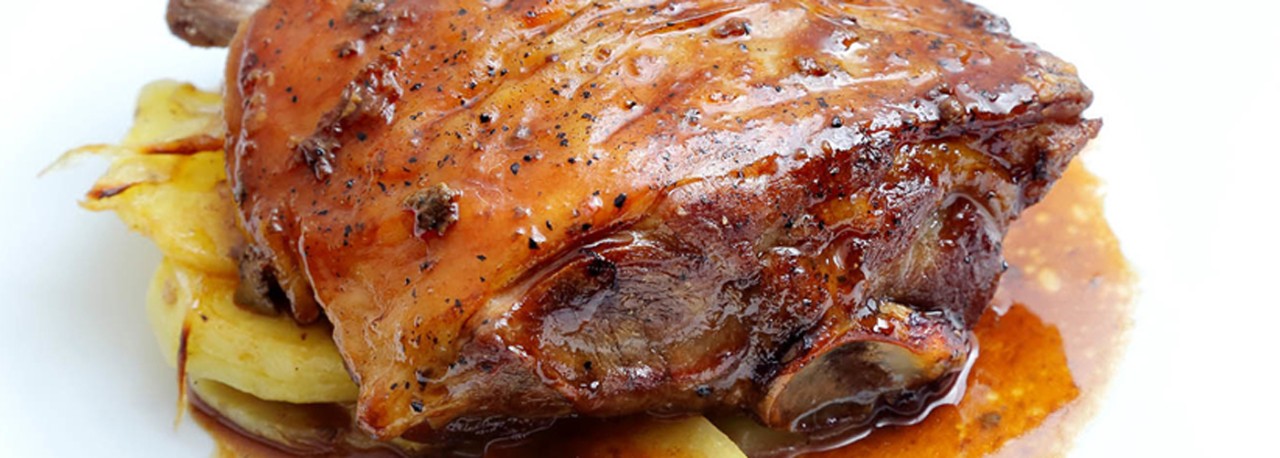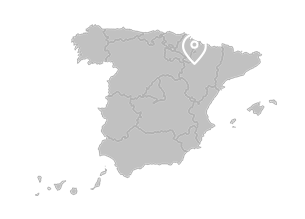.png.transform/rendition-xs/image_image%20(1).png)
Ternasco de Aragón PGI
Lamb from the Rasa Aragonesa, Ojinegra de Teruel and Roya Bilbilitana sheep breeds.
Tasting notes
This is tender, succulent meat with a smooth texture and soft fat, with the beginnings of intramuscular fat, firm to the touch and with a very pleasant bouquet.
Other notes
This type of sheep has certain special characteristics with regard to weight and age at slaughter which set it apart from other types of sheep slaughtered for meat in Spain.
The Rasa Aragonesa breed gives perfectly finished lambs for slaughter, with an average of 25% fat in the male and female for a carcass weight of 10.74 / 23.64 lb. This early development is also seen in the Roya Bilbilitana breed which offers 26.6% fat in both sexes in carcasses weighing 10.6 kg. In the Ojinegra de Teruel sheep, similar percentages of fat are found.
The sheep that produce PGI meat must meet the following requirements:
- Lambs of either sex: entire males and females.
- Conformation: rectilinear profile, with a sub-convex tendency, well-proportioned and slightly rounded outline.
- Live weight at slaughter in slaughterhouse: from 18 kg / 39,6 lb to 24 kg / 52, 9 lb.
- Age at slaughter: from 70 to 90 days.
Characteristics:
- Carcass weight: between eight and 12.5 kg/ 27,5 lb.
- Fat: white external fat, with a firm consistency.
- Cavity fat: white fat covering at least half but never the whole kidney.
- Meat color: pale pink.
Production / Processing method
The agricultural and climatic characteristics of Aragon have favored development of a large sheep-farming sub-sector, sheep being the only species that can adapt to limited, seasonal production of pasture.
The sheep feed on both stubble and the natural pastures they find in Aragon, which include a large number of herbs such as rosemary, thyme, etc.
The lambs are kept stabled where they suckle during the night and eat high-quality concentrated feed during the day. This combination of on-demand feeding with mother's milk allows the lambs to be finished with the right weight at the right age. The use of growth hormones and finishers are prohibited.
When the lambs reach the slaughterhouse, they must be allowed to rest for at least 12 hours before slaughter. During this time, they receive water sweetened with sugar, on demand, in a proportion of one per cent.
The carcasses are aired until the inside of the muscle reaches the ideal temperature for conservation and transport. For periods of under 24 hours, the carcasses are chilled to 3-4ºC / 37-39 ºF and, for longer periods, to 1-3ºC / 33-37ºF. The maximum period of conservation must be no longer than six days.
Geography / Relief and climate
Located in the north-west of the Iberian peninsula, the production area is a region of great contrasts, with different topographical features.The climate is warm-arid, continental Mediterranean. It is windy in the central depression and colder and wetter towards the Pyrenees and the Cordillera Ibérica. Average annual temperatures in the center of the depression are 14-15ºC. In the Somontano mountains, at an altitude of over 1640 ft, the temperature is a couple of degrees lower. Annual rainfall is 1-1.3 ft mm and increases to 2.62 or 3 ft in higher parts.The river system is divided unequally amongst four main basins, that of the Ebro, where most of the territory is located, and those of the Tagus-Guadalaviar-Turia and Mijares.
Regulatory Council
Consejo Regulador de la IGP Ternasco de Aragón
Ctra. de Cogullada, s/n
Mercazaragoza - Edificio Centrorigen
50014 Zaragoza
Tel: (+34) 976 470 813
info@ternascodearagon.es
www.ternascodearagon.es
Sources:
- Spanish Ministry of Agriculture
The lambs are kept stabled where they suckle during the night and eat high-quality concentrated feed during the day. This combination of on-demand feeding with mother's milk allows the lambs to be finished with the right weight at the right age.


- Ternasco 1
- Ternasco 2

Zaragoza (Aragon)
